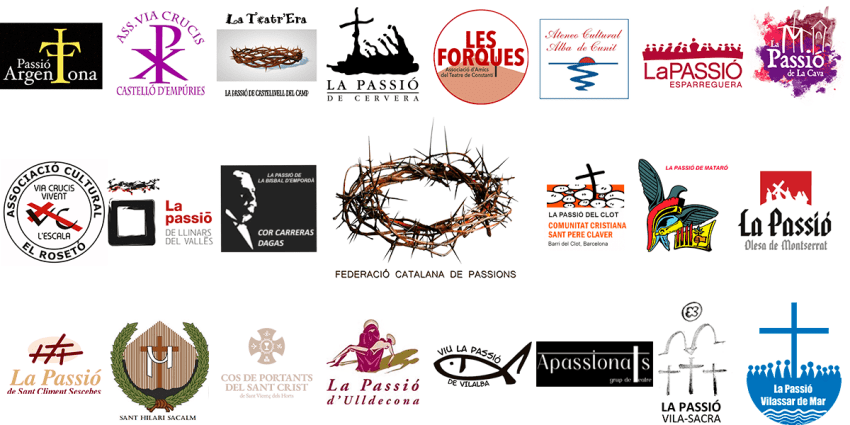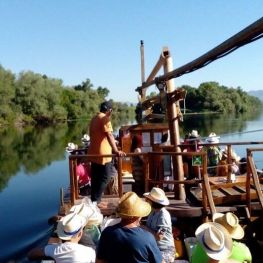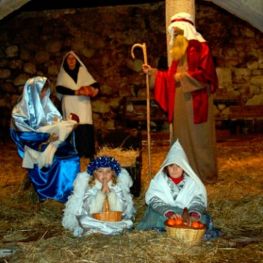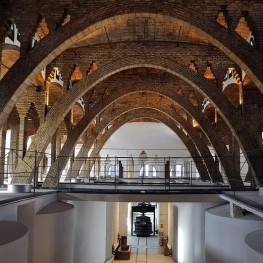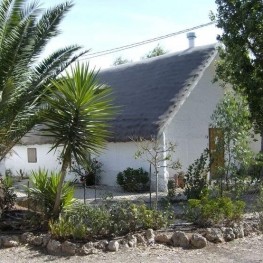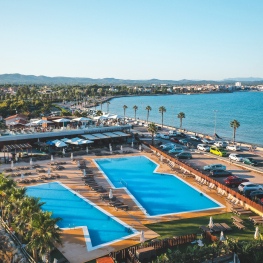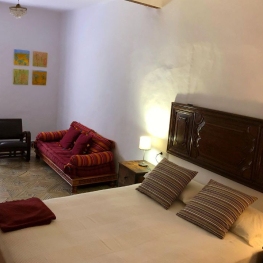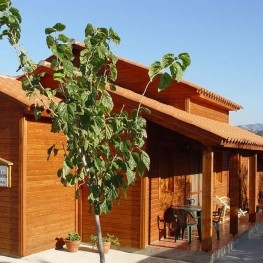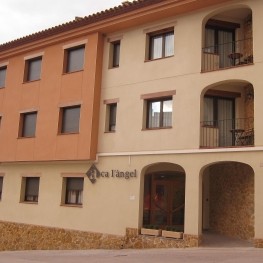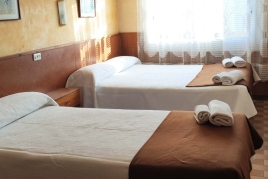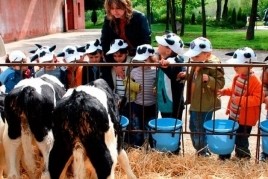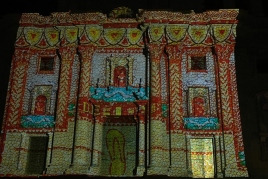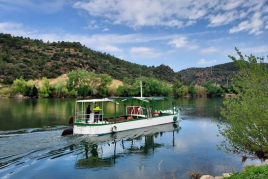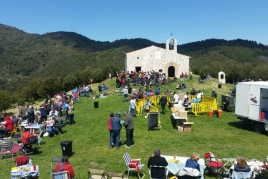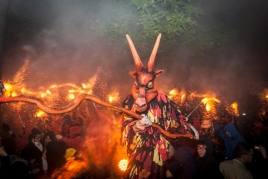Hemingway in Tortosa
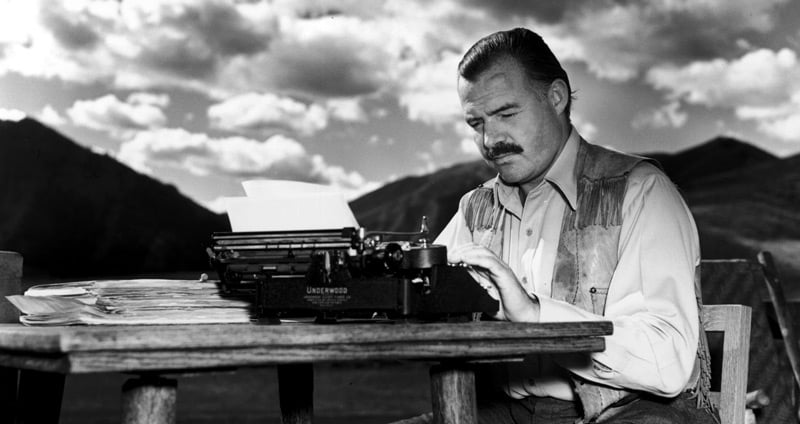
Ernest Hemingway was an American novelist who won the Pulitzer Prize and the Nobel Prize for Literature in 1954.
Throughout his life he had different contacts with the war, since 1918 he enlisted in the Red Cross and driving ambulances in Italy during World War II, working as a journalist, publishing and live isolated from urban society.
During the Spanish Civil War working as a war correspondent and reaches Tortosa on April 4, 1938 to cover the defense of the area of the Lower Ebro before the advance of Franco 's troops: "At two this afternoon, Tortosa was a city almost demolished, evacuated by civilians and no soldiers. Twenty - four kilometers above was fought fiercely to protect Tortosa, the fascist objective in its advanced toward the sea. " And it becomes one of the last to leave the field chroniclers of the Battle of the Ebro.
His last chronicle was the April 18, 1938, near Amposta and hidden behind a field next to the road onions Tortosa and says: "The Ebro Delta has a good, rich soil, and where they grow onions, tomorrow there will be a battle. " March of Spain in late 1938 and lives long periods in Cuba. Dies by suicide in the United States in 1961.
Ernest Hemingway is known for his books and his adventurous style and passionate life.
On this route we propose a walk through the spaces of Tortosa where he was covering the war the writer.
Refugio No. 4
Hemingway on the street is the entrance of the air raid shelter No. 4, one of the more than twenty shelters built to Tortosa to protect civilians from aerial bombardment.
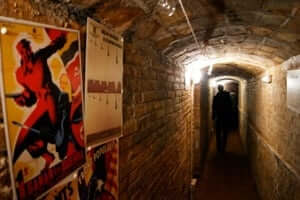 Since the end of the First World War the concept of total war, in which wars do not distinguish the front of the rear spreads. In Tortosa, the Board of Passive Defense reacts with the location of antiaircraft batteries and construction of air raid shelters taking advantage of the topography of the city.
Since the end of the First World War the concept of total war, in which wars do not distinguish the front of the rear spreads. In Tortosa, the Board of Passive Defense reacts with the location of antiaircraft batteries and construction of air raid shelters taking advantage of the topography of the city.
The shelter No. 4, built under the slope in the neighborhood of Algarrobo communicated with other shelter located at the end of the street Teodoro Gonzalez. It had a capacity for 400 people and was the largest shelter of Tortosa. It is a system of galleries of a meter wide and two meters high, carved in clay soil and rounded pebble-paved ground and have been coated with bricks and concrete.
For its part, the Generalitat de Catalunya, through the Health Council of War, established an effective propaganda service with instructions in case of air attack, use of shelters or health organization.
April 15, 1938: 54 tons of bombs
Square of the Baths, one of the few urban spaces that remain of the old fishing district of Tortosa, was completely destroyed by the Italian aviation. Its history goes back to port and commercial origins of the city.
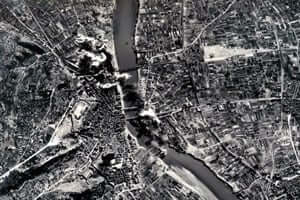 The objectives of aviation were the bridges, the railway station, the power plant and workshops dedicated to the war industry located mainly in Ferreries. The most affected areas are the districts of fishermen and Ferreries, around the station and bridges.
The objectives of aviation were the bridges, the railway station, the power plant and workshops dedicated to the war industry located mainly in Ferreries. The most affected areas are the districts of fishermen and Ferreries, around the station and bridges.
Between February 23, 1937 and December 30, 1938, Tortosa suffered 77 air raids that caused 92 dead and dozens injured. The most destructive attack was on April 15, 1938, Good Friday, when the city received 12 airstrikes, which released more than 54 tons of bombs.
The chronicle of Ernest Hemingway "Bombing of Tortosa" has become one of the most emblematic of his coverage of the Spanish Civil War texts: "Above our heads, the high, cloudless sky, fleet after fleet of bombers flew noisily Tortosa. When they dropped the sudden roar of their loads, the small town on the banks of the Ebro disappeared in a growing cloud of yellow dust. the dust did not get, and attended by more bombers and finally floated as a yellowish mist over all the Ebro valley. "
In the evening of that day, Hemingway made a terrible reflection that helps us capture the moment: "There were many reasons to quit and head to Barcelona Tortosa, including life, liberty and pursuit of happiness".
Republic Square
Plaza Alfonso XII changed its name during the period of the Second Republic and was renamed Republic Square. In the center was a statue of Bishop Ros de Medrano which was demolished in 1932 by an anti - religious riot in reaction to the coup General Sanjurjo.
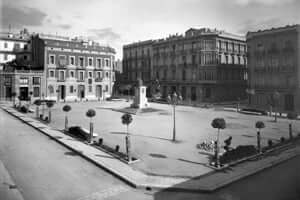 From the first bombings, which used to be nocturnal, people choose to sleep outside the historic center: the suburbs, or the scattered mountain farmsteads. Over time, families are installed permanently and only go to Tortosa to work or to buy. The war advances and March 1938 airstrikes on intensify Tortosa.
From the first bombings, which used to be nocturnal, people choose to sleep outside the historic center: the suburbs, or the scattered mountain farmsteads. Over time, families are installed permanently and only go to Tortosa to work or to buy. The war advances and March 1938 airstrikes on intensify Tortosa.
On April 12, the republican military authorities ordered the total evacuation of the city. The municipality of Tortosa is moved to the village?? Perello. Once evacuated civilians, soldiers Republicans are the only inhabitants of the city. A Republican soldier stationed in Tortosa remembered as: "In most [home] was still the food table and the dishes prepared with completely rotten food, and that told us that those people had to leave homes with much precipitation and surely without being able to take anything that could serve later "(Joaquin Company, Six years away from home).
Meanwhile, the population is distributed Tortosa agricultural area near Tortosa. We know where they took refuge thanks to the book of deaths of the Civil Registry has the place of death of elderly and sick people. The circumstances were not easy: insufficient food, poor hygiene, overcrowding and infectious diseases such as typhus or gastroenteritis.
The municipal market
In the part of the current Generalitat Avenue, Avenue of the Generalissimo to 1981, we find the Municipal Market (1887) which was also affected by the bombing and during reconstruction loses some of the decorative elements of the facade. Market symbolizes the difficulties victual the city.
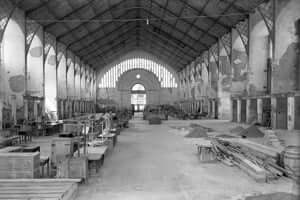 The government has a regulatory selling price for goods and the obligation to obtain authorization to take food from the city. There are fines for selling adulterated dairy milk and fines on Market fishmongers not have weights balances with regulatory pesos. A great flood that resulted in the total loss of winter crop production occurs in October. The situation is critical and output is prohibited grocery Tortosa without authorization from the Municipal Delegation of supply.
The government has a regulatory selling price for goods and the obligation to obtain authorization to take food from the city. There are fines for selling adulterated dairy milk and fines on Market fishmongers not have weights balances with regulatory pesos. A great flood that resulted in the total loss of winter crop production occurs in October. The situation is critical and output is prohibited grocery Tortosa without authorization from the Municipal Delegation of supply.
The evacuation of the city in April 1938 will force people to face life in the mountains with wit and resignation. In some cases, the banter, economic condition or father's trade contributed to alleviating the plight of families. Worsened the food issue: rationing was collected in the municipality of Perelló about 20 km from Tortosa, but many families fed through the exchange, soldiers or ranch raids on orchards near the river.
The city, a large trench
The space where the old medieval fish market was located and was moved stone by stone to the Municipal Park in 1933 is located on the left bank of the river and the neighborhood of Ferreries is located on the right bank.
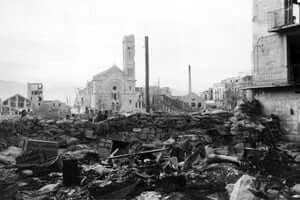 Franco 's troops occupy Ferreries on April 18, 1938 and the Republican army stayed on the left bank. The Ebro separates the two armies and the city becomes war front for nine months. Franco waiver to avail of Tortosa and crush the greatly worn republican army, and seize Barcelona, where it remained the government of the Republic, which would precipitated the end of the war. Tortosa is a quiet front.
Franco 's troops occupy Ferreries on April 18, 1938 and the Republican army stayed on the left bank. The Ebro separates the two armies and the city becomes war front for nine months. Franco waiver to avail of Tortosa and crush the greatly worn republican army, and seize Barcelona, where it remained the government of the Republic, which would precipitated the end of the war. Tortosa is a quiet front.
In the abandoned houses, food quartered soldiers found and coats. But not only the soldiers took advantage of the situation. To prevent further looting, a control in the Plaza del Rastro which prevented the entrance to the city to all those refugees in the mountains who wanted to go "home" to find food was established.
The architectural heritage also suffered the ravages of war as evidenced by the remains of the church of Sorrows in the Plaza de los Dolores. Although a part of the rich artistic heritage tortosino had been burned and looted the beginning of the war, the city evacuated the bulk of the Treasury of the Cathedral and files were taken to Barcelona. However, the Treasury of the Cathedral, which include the largest reliquary of the Virgin of the Tape (1619) or the chalice of Pope Luna (XIV century), will not return to Tortosa once the war ended. It seems that he was taken to France during the withdrawal and from there embarked on Mexico to help maintain Republican exiles.
The blown-up bridges
Along the river in the old railing River Street, we see the bridge state where he passed the national road. Oliver was behind the Boteller palace, destroyed during the war, whose facade was moved stone by stone in 1962 on the site of the old medieval town hall in the street Doctor Ferran.
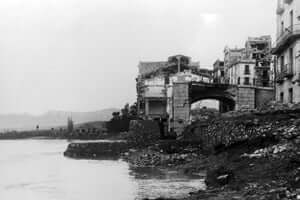 Tortosa had three bridges over the Ebro river: the railway bridge, the bridge of the State and the bridge Cinta latter bridge was not rebuilt after the war ended and now the central pillar serves as a base of the monument erected. by Franco in 1966 to remember those killed during the Battle of the Ebro.
Tortosa had three bridges over the Ebro river: the railway bridge, the bridge of the State and the bridge Cinta latter bridge was not rebuilt after the war ended and now the central pillar serves as a base of the monument erected. by Franco in 1966 to remember those killed during the Battle of the Ebro.
The bridges were the main target of the air strikes, but there is confusion between the dates and authorship of their destruction. It seems that the bombing of April 15 hit the bridge structure of the State, as relates Hemingway: "So when our car came to Tortosa and the guard told us that the bombers had blown up the bridge and we could not pass, was I feared for so long and so often that almost did not affect us beyond feeling that had now actually happened (...). the railway bridge still endures and there is no doubt that a pontoon bridge will be built, but this is a bad night for the west bank of the Ebro. "
Italians in Ferreries
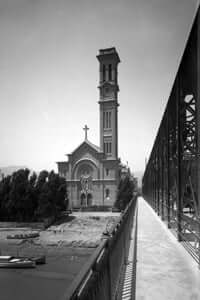 Ferreries was the neighborhood that housed the militarized industries such as smelting Salas, who was moved to Vic to avoid being destroyed by bombing.
Ferreries was the neighborhood that housed the militarized industries such as smelting Salas, who was moved to Vic to avoid being destroyed by bombing.
The steeple of the church of the Rosary, neo - Romanesque style, was used to locate machine guns, during its reconstruction lost 12 meters high.
With Franco at the gates of the city troops, Tortosa bridges were blown up by Republican bombers in an action to halt the progression of Franco's army on the left bank. Italian soldiers of the Corpo Truppe Voluntarie Mussolini occupy Ferreries on April 18, 1938: "At eight o'clock, five tanks have exceeded Roquetes and have come to Tortosa, in 'The same Tortosa' as the Spaniards say they have reached the iron bridge had been blown up an hour earlier. Tortosa has been occupied and river divides the city into two parts. "
Crossing the river
Paiolet Square is one of the few open spaces of the old river facade of Tortosa. After the war, a road for cars in front of the river facade was built, which transformed the appearance of the city.
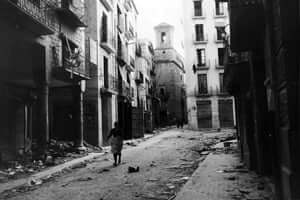 Franco 's troops occupied the left bank of Tortosa on 13 January 1939 and Franco's army crosses the river between 6 and 7 am, but continues to the Perello without leaving any soldier in the city. No bridges and river crossing is done by barge. The supply trucks go through a bridge in Mora de Ebro.
Franco 's troops occupied the left bank of Tortosa on 13 January 1939 and Franco's army crosses the river between 6 and 7 am, but continues to the Perello without leaving any soldier in the city. No bridges and river crossing is done by barge. The supply trucks go through a bridge in Mora de Ebro.
The first actions of the occupants are to deliver food to the hungry and frightened to earn their membership population. The city lacks everything and becomes progressively return. "We, as there was no habitable house, when it got dark, we came back again to the mountains. Here there was no light, no water, no gas..." (José Monllaó Panisello Llaonet, Spanish Journal 01/13 / 1954)
Return
In the Plaza del Angel, one of the nerve centers of Tortosa, he was originally found the Gothic fountain that is now attached to the Palace Oliver Boteller located in Doctor Ferran.
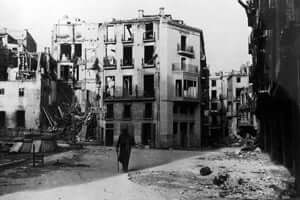 The population sheltered in the mountains, return to the city where uninhabitable houses and looted goods will be found. But not everyone returns and the historic town of Tortosa loses more than 2,000 inhabitants.
The population sheltered in the mountains, return to the city where uninhabitable houses and looted goods will be found. But not everyone returns and the historic town of Tortosa loses more than 2,000 inhabitants.
The courtyard of the Convent of the Immaculate will act pre - trial detention to detention in prison Pilate Tarragona. During Franco's repression must be added that, mayors, doctors, religious and right-wing citizens were killed during the first months of the war. The wounds of the civil war in Tortosa take long to heal. The moral rehabilitation of victims will be a long task.
Tortosa has been captured by General Franco found a desolate and destroyed and no signs of city life. With this victory, Franco isolates Barcelona, democratic capital, Valencia and Madrid. For some, this represents the last chapter of the Civil War.
reconstruction
Spain Square is a space where the work and style of rebuilding the city, which is an arcaded square Castilian forms is evident.
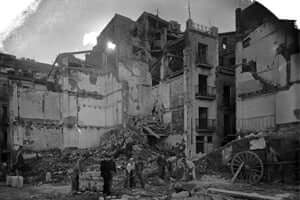 In January 1939 a municipal commission manager takes charge of city government and reconstructive activity begins.
In January 1939 a municipal commission manager takes charge of city government and reconstructive activity begins.
The state of Tortosa was catastrophic, about 3,000 buildings had some kind of destruction. Of the noble buildings, except the Royal Colleges, which served to detain citizens rights, none was saved from the bombing. Stalls Cathedral Choir Renaissance style, was hit by a bombardment; Cathedral has a keystone with pre - constitutional shield and a total of 600 buildings were unrecoverable.. "All the streets were full of debris and rubble In many houses, through them, you could enter the first floor addition it was a bitter cold and the river was about to boil over. " (José Monllaó Panisello Llaonet, Spanish Journal 01/13/1954).
The task of physical reconstruction of Tortosa is?? last until late 1950; overcoming the trauma experienced by the population will take longer to be achieved.
You may also be interested in: Get carried away by the culture: literary femturisme | The Civil War, exile and repression in Catalonia
What to do
Pessebre Vivent de Jesús
Tortosa (a 1.8 Km)Living nativity scene represented in movement and voice, from the Catalan period…
Jardí Botànic Medicinal, Ecoherbes Park
L'Ampolla (a 14.1 Km)The Ecoherbes Park Medicinal Botanical Garden is a large natural area next…
Cooperativa de Gandesa
Gandesa (a 27.9 Km)You can visit the cooperative as designed by Cesar Martinell, with the…
Where to eat
L’Estany - Casa de Fusta
Amposta (a 21.2 Km)Regional cuisine restaurant, with a wide sample of the ancestral cuisine of…
Where to sleep
Càmping Taiga Delta de l'Ebre
L'Ampolla (a 14.9 Km)3-star campsite located on the Arenal beach, at the gate of the…
Apartaments Les Valletes
Arnes (a 24.6 Km)Wooden houses fully equipped. With garden for relaxation.
Ca L'Àngel
El Pinell de Brai (a 27.7 Km)Small accommodation with very cozy and modern rooms, located in the center…

